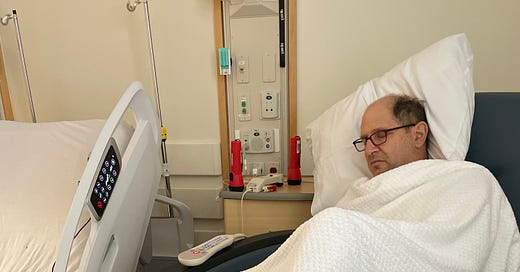An update might be in order here - with fair warning that my brain has not fully emerged from its fogginess so this might ramble a bit. But here’s the lede: Stacy sprung me from Brigham and Women’s Hospital after 3.5 days, which as noted in my last post, is where I was admitted on Saturday (aka Day +5). I’m now recovering well at home.
Not Conducive to Sleep
The ironic thing about a hospital is that at a time when you’re most in need of rest, you are in an environment least conducive to sleep. Between vitals checks, housecleaning, neurotoxicity checks (please do not ever ask me to count backwards from 100 by 10s ever again), regular nurse checks, and the incessant beeping from the nurse’s station which echoes through the floor, and the weirdly glowing lights in the hospital room, sleep happens constantly, but only in small increments.
It’s one of the many reasons why healing at home is always preferred if it’s safe to do so. But for the last three days, it would have been riskier for me. One of the most common side effects of CAR-T cell therapy is a fever, which along with a drop in blood pressure and/or oxygen saturation, may be indications of Cytokine Release Syndrome (or CRS). It’s a syndrome that happens as your CAR-T cells multiply like crazy and your immune systems goes into overdrive. We like to think of it as my body developing its superpowers, like a new Spiderman of sorts.
So while the spiderweb ability would be all well and good, the rest of the whole CRS thing isn’t. It typically starts in the Day +3 to Day +5 time frame, which is part of the reason you need to be close to the hospital for the first 7-10 days. At the first change of vital signs, which can develop after CRS, and you get a “proceed directly to the hospital, do not pass go” card. And so when my fever hit 101 around 2:30 am on Saturday morning, the on-call CAR T doctor quickly returned the page and instructed us to take the emergency dexamethasone and Tylenol to keep the fever down. That did the trick and let us avoid the dreaded ER and when I showed up for my appointment later that morning, my admittance plan was already in the works.
The main objective of being in the hospital was to closely monitor me for fever or any signs of neuro issues. One of the ironies of this was that even though Tylenol would reduce my fever, they don’t want to give it prophylactically for fear that it would mask the fever and make it more difficult to know if I was truly experiencing CRS. So I hovered in the hospital for a day or so with a “high” normal temp but it never got above the actual temp threshold and as my other inflammatory markers were going down, after 48 hours I was released for good behavior.
Are Symptoms Good or Bad?
One of the inherent paradoxes of cancer treatment is that no one wants to have side effects. I desperately did not want any neurotoxicities and was hoping to sail through unscathed without fever or hospital admission. Yet at the same time, you almost want some signs that the treatment is working - some physical manifestation that something is happening. And so while I wasn’t happy to have felt these flu-like symptoms for two or three days, part of me is glad to physically know that the CAR-T cells were beginning to do their job. We’ll see how it plays out in August or so when we do our next scans.
Until then, I’m just glad to be at home in my comfortable surroundings, with my family, and of course, my dogs.






Looking good Michael - so glad you’re home with your peeps and puts. Thought of you the other night when Alonso went deep. Hope your recovery continues as smoothly as possible. 👍🏻
I totally understand that you wanted a sign that the treatment is working…despite the fact that the sign caused an inpatient stay. I’m glad it was short and that you’re now home and comfy with the dogs and family. ❤️❤️❤️